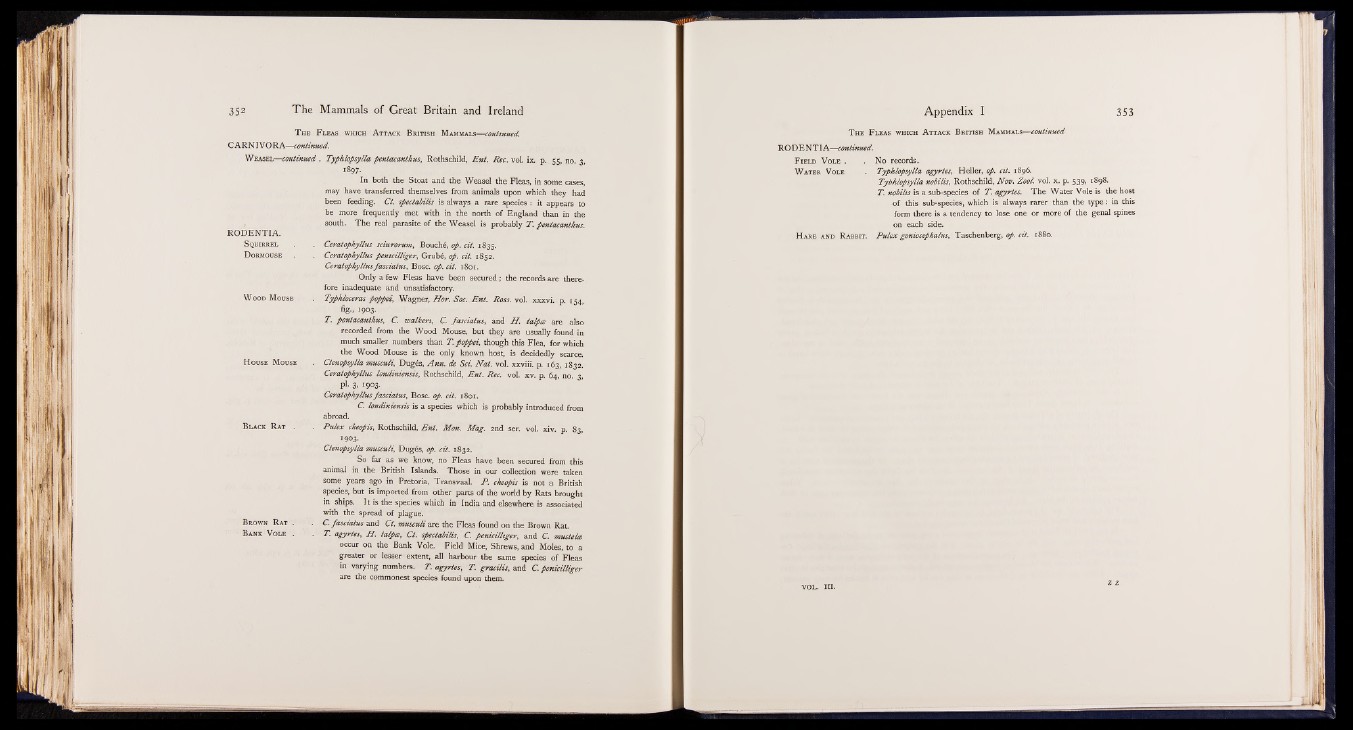
T he F leas which A ttack British Mammals— continued.
C A R N IV O R A — continued.
W easel— continued . Typhlopsylla pentacanthus, Rothschild, E n t. R ec. vol. ix. p. 55, no. 3,
1897.
In both the Stoat and the Weasel the Fleas, in some cases,
may have transferred themselves from animals upon which they had
been feeding. C t. spectabilis is always a rare species: it appears to
be more frequently met with in the north o f England than in the
south. T he real parasite o f the Weasel is probably T . pentacanthus.
R O D E N T IA .
S quirrel
Dormouse
W ood Mouse
H ouse Mouse
Ceratophyllus sciurorum, Bouché, op. cit. 1835.
Ceratophyllus p en icillig er, Grubé, op. cit. 1852.
Ceratophyllus fa scia tu s, Bose. op. cit. 1801.
Only a few Fleas have been secured ; the records are therefore
inadequate and unsatisfactory.
Typhloceras poppei, Wagner, H o r. Soc. E n t. Ross. vol. xxxvi. p. 154,
%» 1903-<
T . pentacanthus, C . w a lken, C. fa scia tu s, and H . talpce are also
recorded from the Wood Mouse, but they are usually found in
much smaller numbers than T . poppei, though this Flea, for which
the Wood Mouse is the only known host, is decidedly scarce.
Ctenopsylla musculi, Dugés, A n n . de S ci. N a t. vol. xxviii. p. 163, 1832.
Ceratopkyllus londiniensis, Rothschild, E n t. Rec. vol. xv. p. 64, no. 3,
pl- 3> 1903-
Ceratophyllus fa scia tu sy Bose. op. cit. 1801.
C. londiniensis is a species which is probably introduced from
B lack Rat
Brown Rat .
Bank V ole .
abroad.
P u le x cheopis, Rothschild, E n t. Mon. Mag. 2nd ser. vol. xiv. p. 83,
1903.
Ctenopsylla m usculi, Dug6s, op. cit. 1832.
So far as we know, no Fleas have been secured from this
animal in the British Islands. Those in our collection were taken
softie years ago in Pretoria, Transvaal. P . cheopis is not a British
species, but is imported from other parts o f the world by Rats brought
in ships. It is the species which in India and elsewhere is associated
with the spread o f plague.
C. fa scia tu s and C t. m usculi are the Fleas found on the Brown Rat.
T . agyrtes, H . talpce, C t. spectabilis, C. p en icillig er, and C. mustela
occur on the Bank Vole. Field Mice, Shrews, and Moles, to a
greater or lesser extent, all harbour the same species o f Fleas
in varying numbers. T . agyrtes, T . g ra cilis, and C . p en icillig er
are the commonest species found upon them.
T he F leas which A ttack British Mammals— continued
R O D E N T IA — continued.
F ield V ole .
W ater V ole
H are and Rabbit.
No records.
Typhlopsylla agyrtes, Heller, op. cit. 1896.
Tybhlopsylla nobilis, Rothschild, N ov. Zool. vol. x. p. 539, 1898.
T . nobilis is a sub-species o f T . agyrtes. T he Water Vole is the host
o f this sub-species, which is always rarer than the typ e : in this
form there is a tendency to lose one or more o f the genal spines
on each side.
P u le x goniocephalus, Taschenberg, op. cit. 1880.
VOL. III. Z z